| Back to Back Issues Page |
 |
|
Bangkok Travelbug May 14 Bang Pakong the Dragon River Chachoengsao April 29, 2014 |
| Hello
Bang Pakong River The head waters of the Bang Pakong originate from the foothills of the Korat plateau and flows through Prachinburi province north-east of Chachoengsao. As it turns south, it is joined by the Nakhon Nayok River from the neighbouring province. The river twists and turns its way down south across the western portion of the Chachoengsao till it drains into the Gulf of Thailand at Bang Pakong district. 
Bang Pakong River near Ban Mai Market To the people of Chinese origin living in Chachoengsao, the river with its sharp meanders appears like the mythical Chinese dragon which symbolizes success and good fortune. Siew Hwei, a friend from Singapore and I took a drive along the banks of the Bang Pakong one Saturday morning to visit three old places of interest by the river; a temple, a church and a riverside community with a market. Table of contents Wat Sothon Wararam Worawihan Our first stop was at Chachoengsao town itself to visit a beautiful temple, Wat Sothon Wararam Worawihan. The temple is named after the legendary Phra Phuttasothon or Luang Por Sothon, a revered Buddha image that is housed within the temple. 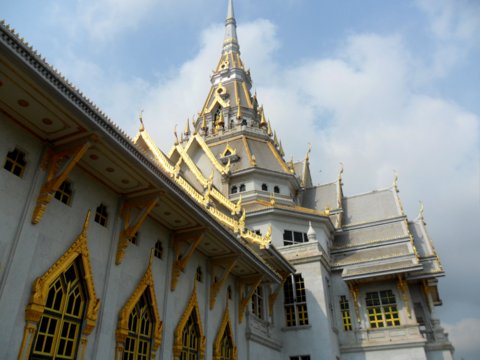
Wat Sothon Wararam Worawihan When we arrived we went first to a building next to the temple to see a cultural dance in progress that was watched by many worshippers. This solo performance was beautiful. 
Brilliant performance - photo courtesy of Lim Siew Hwei This temple, also known as Wat Hong, was built during the Ayutthaya period and is famous for its Buddha image. According to legend, this image floated down the Bang Pakong and was recovered after much difficulty near the site of the present temple. A temple was built to house this image that’s highly respected in Chachoengsao. 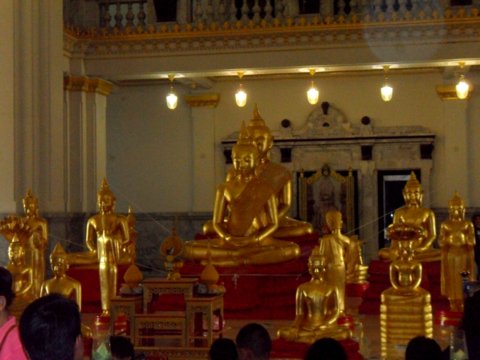
Inside the ubosot or ordination hall The spectacular ubosot or ordination hall is relatively new. I remember it was different from my first visit in the late 1990s. 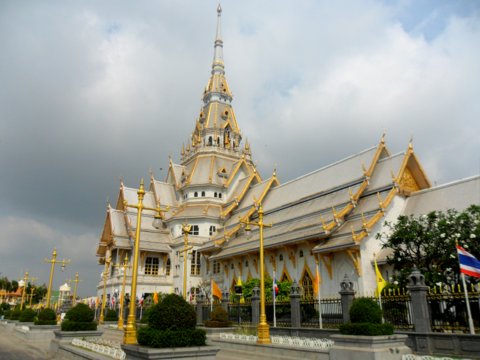

View of the temple from the river There’s also a Chinese temple within the grounds of the temple closer to the river evidence of the strong Chinese heritage in the province. 
Chinese temple Table of contents St Paul’s Church Our next stop was further up-river; we crossed the bridge to the east bank of the Bang Pakong and turned into a narrow soi. Our way in was flanked by isolated houses and fruit trees giving the place a distinct rural atmosphere. We had a pleasant surprise when we reached our destination. 
Statue of St Paul with the ruins of the old church in the background to the left St Paul was a famous Apostle who lived in the 1st C AD. As a young man, he was called Saul of Tarsus, a zealous persecutor of the early Christians. One day while on the road to Damascus, a divine vision appeared before him which had a profound impact on his life. He ceased persecuting Christians and became a devout Apostle spreading the Gospel suffering persecution himself. There are many churches in the world dedicated to St Paul. One of them is in Chachoengsao. The St Paul’s Church here has a long history. In 1838 during the reign of King Rama III, a Catholic priest visited Chachoengsao and found that they didn’t have a church. Two years later, the first church in the area was built from bamboo. It was only in 1872 during another visit by a Catholic priest that funds were raised to buy a piece of land on the eastern bank of the Bang Pakong to build a permanent building. The new church had a mix of Gothic and Roman architecture with twin steeples. 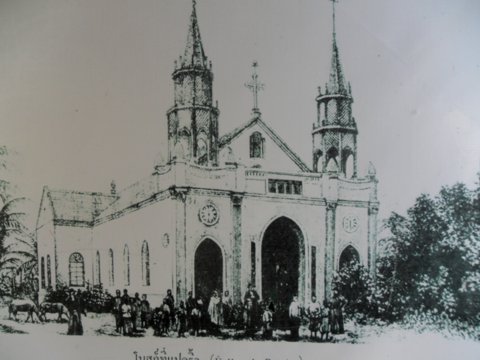
Sketch of the church displayed in the ruins Chinese labourers constructed this church of brick and mortar and left evidence of their efforts with an inscription in Chinese above the main door, "House of God". The Thanksgiving service was held on completion in 1873. St Paul’s Church became the religious centre of the Catholic community in Chachoengsao, most of whom were Chinese immigrants from China. When the church celebrated its 100th anniversary in 1971 funds were raised for new church and it was decided that the existing building be demolished. 
The new St Paul’s Church Demolition work started and the old building was gradually torn down. When they reached the front wall, they found that it just couldn’t be knocked down. So it was preserved as a monument to reflect the history and lives of the community in the early days. 
The preserved façade of the old St Paul’s Church 
Close-up of the old walls – photo courtesy of Lim Siew Hwei 
Statue of St Paul at the entrance to the ruins 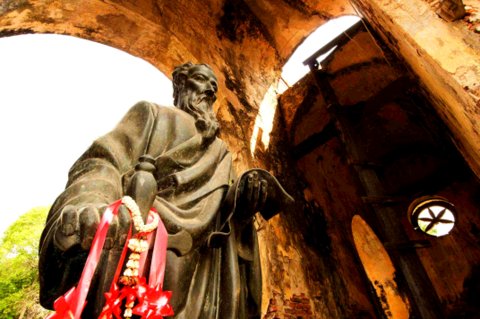
Close-up of St Paul – photo courtesy of Lim Siew Hwei There’s a small community living on the banks between the church and the river where there is a wooden pier with a ferry service to get across to Wat Laem Tai. 
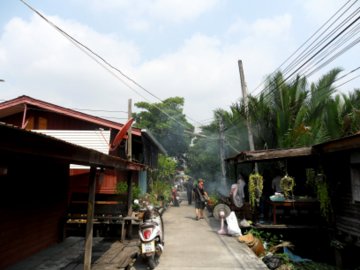
During our visit that morning, some residents were busily barbecuing Thai delicacies over an open fire. This delicacy, called "kanom jark", is made from minced taro mixed with coconut and sugar, then wrapped in banana leaves and barbecued. 
Kanom jark – photo courtesy of Lim Siew Hwei Table of contents Ban Mai Riverside Market Our last stop in this land leg of our journey was to an old riverside community with a market. The Ban Mai Market Community is a Thai Chinese community that has been living on the banks of the Bang Pakong for 100 years. 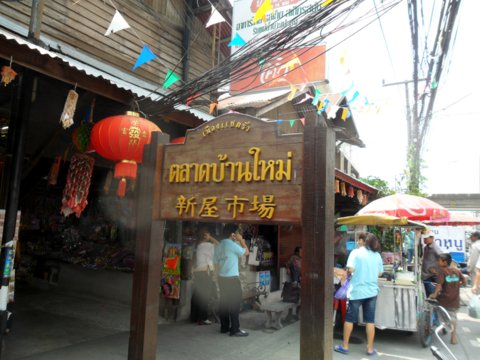
Main entrance to the market As the main river passing through Chachoengsao, the Bang Pakong was the main channel of economic activity and trade in the old days when water travel was popular. This riverside community preserves the way of life with a mix of Chinese and Thai cultures that has been passed down through the generations. 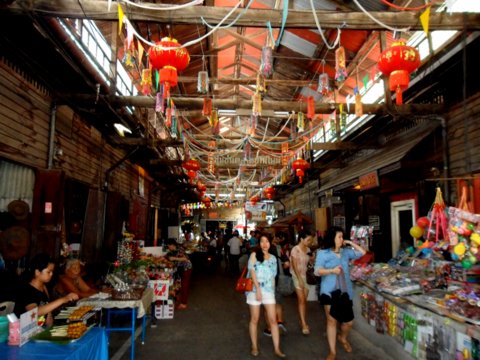
Strolling through the market There are lots of food and souvenirs on sale at this weekend market that is run by the residents. 
Of particular interest were, of course, the food items on display. 
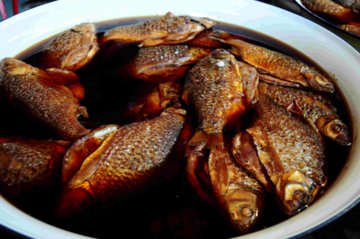

Photos courtesy of Lim Siew Hwei The Ban Mai Market has two sections; the first section near the main entrance is made of old wooden buildings, the second section is apparently newer as the buildings are concrete. There’s a popular seafood restaurant there that was very well patronized. Here’s what we had for lunch; deep fried sea bass with sweet sour sauce garnished with mango strips, fried morning glory and fresh rock oysters. Before 

After 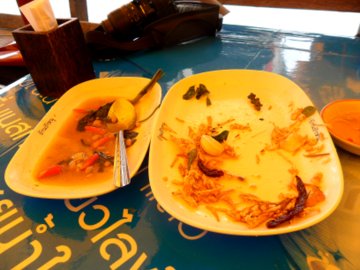
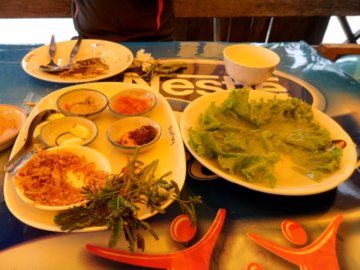
After lunch, we stopped at this old coffee shop for some traditional coffee. The owner has been running this coffee shop for the last six years after taking over from his father who operated the shop for 30 years. 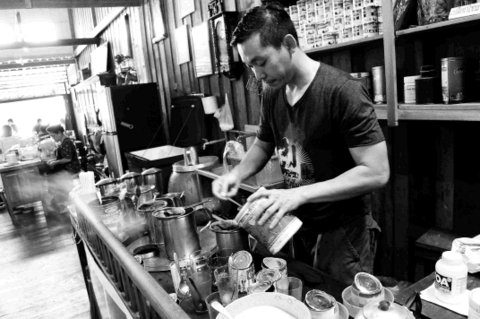
The traditional brew – photo courtesy of Lim Siew Hwei Along the way we found this old Chinese shrine, a common feature in the area. The name of the shrine perhaps it’s a reflection of the hopes of the early immigrants who built it. 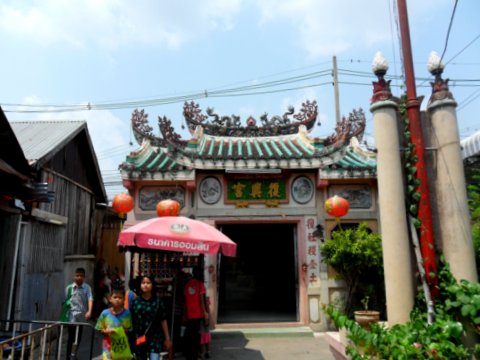
Fu Xing Gong – Revival Palace When we reached the other end of the market, we found a wooden pier and a lady sitting at a table with a poster of Ganesha the Elephant God. At first glance I mistook her for a fortune teller. It took a second look to realize that she was selling tickets for a boat ride to tour the Bang Pakong River and an island in the river with an unusual temple, Wat Samarnratnaram. That’s what we will be covering next month. Join us again as we take a boat tour on the Bang Pakong River. Table of contents Map to Bang Pakong River attractions View Bang Pakong River tour in a larger map Opening hours Wat Sothon is open every day from 9:00 am – 5:00 pm The grounds of St Paul’s Church are open every day though the main church building is locked except on Sundays. The Ban Mai Market is open on weekends and public holidays 9:00 am – 5:00 pm Admission to all these places is free How to get there By car To Chachoengsao and Wat Sothon Take Motorway 7 or the Bang Na – Chonburi Express, Highway 3, and then turn into Highway 314. Keep going till you get to Chachoengsao town where Wat Sothon is located. To St Paul’s Church Drive along Maruphong Road that runs on the west bank of Bang Pakong until you get to the bridge. Cross the bridge to Sukprayoon Road and turn left into Sukprayoon Soi 9. Careful, the road sign to this soi isn’t very prominent, so drive slowly on the left. Drive along the winding Sukprayoon Soi 9 until you get to a T junction, turn left to St Paul’s Church. There’s ample parking within the church grounds. To Ban Mai Market Re-cross the bridge to the west bank and drive along the banks of the Bang Pakong till you get to Ban Mai Market. Visitors’ parking lots are opposite the market on the road that leads to Wat Thep Nimit. Table of contents My thanks Thank you Lim Siew Hwei for driving us for the trip, the sumptuous lunch and his beautiful photos. Table of contents Next month River boat tour of the Bang Pakong If you enjoyed reading this e-zine, please forward it to a friend. If you received this from a friend and found it interesting, please subscribe at Bangkok Travelbug. What you think of the Bangkok Travelbug? We love to hear from you What other subscribers have said Till next month then. Eric Lim Find us on Facebook Stay updated with what’s new at Tour Bangkok Legacies. Copy the link below and paste it into your Google Reader, NetNewsWire or your favourite feed reader. https://www.tour-bangkok-legacies.com/tour-Bangkok-legacies.xml If you use My Yahoo! or My MSN, head over to my home page and click on the button for your favourite Web-based feed reader. Visit our home page at Tour Bangkok Legacies. Copyright@2008-2014 Tour Bangkok Legacies All rights reserved |
| Back to Back Issues Page |
